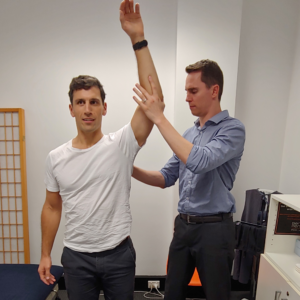As an avid beach goer and recently converted ocean swimming enthusiast, nothing compares to a weightless glide through the ocean before the early morning coffee. Swimming is a great form of exercise which combines a full body work out with the benefits of being low impact and is also great for cardiovascular fitness. A common injury associated with swimming is “Swimmers Shoulder”.
What is Swimmer’s Shoulder you ask? Well the definition isn’t really clear as it is an umbrella term for irritation and overuse of a number of shoulder and non-shoulder structures. The literature doesn’t specifically offer a definition, so to help you understand let’s explore the topic a little more.
So what are some of the potential causes and structures involved?
Think of Swimmer’s Shoulder as any shoulder pain that originates from swimming. More specifically it is attributed to overuse injuries, particularly of the rotator cuff or the biceps tendon. It can include shoulder impingement or bursitis of the shoulder, and is sometimes even attributed to referred pain to the shoulder from other structures like the cervical spine. A murky term indeed when you consider everything that could be involved in being diagnosed with this condition.
To go a little deeper, typically swimmers develop strong shoulder internal rotators and adductors (the muscles which give swimmers a broad torso) while opposing muscles like shoulder external rotators may be under used. With poor technique this can lead to impingement or irritation in certain positions of your stroke.
A hypermobile shoulder has altered biomechanics compared to a ‘normal’ shoulder, especially with repetitive actions like freestyle swimming. Often this can lead to irritation in a number of structures causing the murky diagnosis of Swimmers Shoulder.
The neck is also a source of pain to the shoulder and with increased activity in repetitive rotation the neck can become irritable causing referred pain to the shoulder region leading to, you guessed it, Swimmers Shoulder.
Due to the increased range of motion in the shoulder, and the large arc of movement required to perform the swimming stroke there is occasional overuse of soft tissue structures like the capsule and labrum. This overuse can cause tears in the labrum, capsule, ligament, tendon, bursa and other soft tissue. Often leading a clinician to diagnose a swimmer with our favourite condition – Swimmers Shoulder.
The scapular (also known as the shoulder blade) supports a number of important muscles which control shoulder stability and allow for shoulder movement. Occasionally there could be an asymmetry in shoulder control with one scapular not containing the appropriate amount of strength, endurance, muscular control or flexibility leading to decreased stability. With the repetition of swimming strokes this can cause irritation. I think you know where this is going.
There are many reasons you could have Swimmers Shoulder, often one diagnosis is completely different to another, yet both are termed Swimmers Shoulder. The good news is, as Physio’s, we can treat all of these potential causes. So the most important take home message is to have your Physio accurately diagnose where your shoulder pain is coming from. This is essential to receive the correct treatment and ongoing management so you are free of pain while swimming.
If you are suffering from painful swimmers shoulder and would like to have this assessed come in and see one of our expert clinicians at Bend + Mend in Sydney’s CBD.






